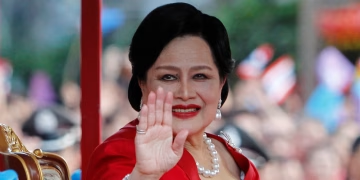U.S. President Donald Trump will meet Chinese President Xi Jinping on October 30, 2025, in Busan, South Korea. This high-stakes bilateral meeting forms part of a broader diplomatic tour across Asia. White House Press Secretary Karoline Leavitt confirmed that the meeting will take place in the morning, before President Trump returns to Washington.
Governments, businesses, and analysts around the globe are closely watching this summit. Observers expect discussions on trade, national security, and global stability. Additionally, the meeting will test whether both leaders can overcome years of tension and establish a more constructive relationship.
Background and Context
This summit marks the first in-person encounter between Trump and Xi since 2019. Their relationship has included intense trade disputes, diplomatic disagreements, and public statements reflecting mutual suspicion. Most recently, the U.S. government imposed 100% tariffs on Chinese imports, effective November 1, following China’s new export controls on rare earth minerals.
Despite these tensions, President Trump has expressed optimism about the potential for a “fantastic deal” with China. He emphasized his personal relationship with President Xi and highlighted the opportunity to resolve pressing issues. Analysts note that both leaders have strong political incentives to show progress, particularly amid mounting global economic pressures.
The Asia Tour
President Trump’s visit to South Korea is part of a broader tour that includes stops in Malaysia and Japan. In Malaysia, he will meet Prime Minister Anwar Ibrahim and attend an ASEAN leaders’ working dinner. During the visit, Trump plans to discuss trade partnerships, regional security, and collaborative economic initiatives with ASEAN members.
Next, in Japan, he will meet newly appointed Prime Minister Sanae Takaichi. Discussions are expected to cover regional security, U.S.-Japan economic ties, and coordination on technological innovation. Observers note that Japan and South Korea serve as key U.S. allies in the Indo-Pacific region, making these meetings strategically important.
The Asia-Pacific Economic Cooperation (APEC) summit in Busan, scheduled from October 31 to November 1, will provide the backdrop for these diplomatic engagements. Before meeting Xi, Trump will attend the APEC CEO Summit, where business leaders and government officials will discuss trade, investment, and sustainable economic growth.
Bilateral Meeting with Xi
The Trump-Xi meeting will focus on several pressing issues. First, trade relations will dominate the agenda. The U.S. tariffs and China’s export controls on rare earth minerals have heightened tensions. Both sides are expected to explore ways to ease friction and prevent escalation in global markets.
Second, national security concerns will feature prominently. The leaders will likely discuss cybersecurity, intellectual property, and sensitive technology transfers. Analysts suggest that both nations will aim to create clearer frameworks for cooperation, even if progress occurs incrementally.
Third, global stability will take center stage. President Trump has emphasized that ending Russia’s war in Ukraine will be a top priority. He indicated that President Xi now supports diplomatic efforts, making the topic critical for coordinated international action. International stakeholders are watching closely, since any agreement could influence European and Asian security dynamics.
Implications for U.S.-China Relations
The summit could significantly shape bilateral relations. A successful meeting may ease trade tensions and foster cooperation on global challenges. In contrast, a failure to reach meaningful agreements could further strain relations, increase uncertainty for investors, and disrupt global economic stability.
Moreover, the summit could influence public perception and domestic politics in both countries. In the U.S., Trump positions himself as a tough negotiator with China. In China, Xi may use any positive outcome to reinforce his leadership credentials and showcase China’s growing global role.
Strategic Dimensions
Beyond trade and security, the summit represents a broader strategic dialogue. Both leaders are expected to discuss supply chain resilience, technological innovation, and regional influence in the Indo-Pacific. These discussions could shape future cooperation in artificial intelligence, green energy, and infrastructure projects.
Furthermore, the summit may impact multilateral forums. Agreements or frameworks forged bilaterally may influence negotiations at APEC and other regional summits. Observers note that even limited U.S.-China collaboration could set precedents for global economic governance and cross-border policy coordination.
Challenges Ahead
Several challenges may limit the summit’s effectiveness. First, domestic pressures in both countries could constrain flexibility. In the U.S., Congress and business leaders may resist concessions. In China, bureaucratic and regional interests could complicate implementation.
Second, historical distrust may slow progress. Both nations have previously seen negotiations break down due to differing interpretations of commitments. Analysts suggest that careful follow-up and monitoring mechanisms will be essential.
Third, external geopolitical pressures could overshadow outcomes. Tensions involving Taiwan, North Korea, and the South China Sea remain unresolved. Any escalation could divert attention from trade and economic discussions, requiring careful diplomatic management.
What to Watch
Observers will closely monitor several key indicators in the coming weeks:
- Trade Agreements: Will the U.S. and China agree to ease tariffs or export restrictions?
- Security Cooperation: Will the leaders outline clear commitments on cybersecurity and intellectual property?
- Global Diplomacy: Will they coordinate on Ukraine or other international crises?
- Public Messaging: How will both countries frame the summit outcomes domestically and internationally?
- Follow-Up Mechanisms: Will the leaders create systems to monitor agreements and ensure compliance?
Additionally, analysts will watch whether this summit generates momentum for future engagement or signals only a temporary pause in heightened tensions.
Conclusion
The Trump-Xi meeting in Busan represents more than a standard diplomatic engagement. It brings together two influential leaders during a time of economic uncertainty, security concerns, and global interdependence. Success could stabilize trade, promote technological cooperation, and improve dialogue on global issues.
Conversely, failure could exacerbate tensions, disrupt markets, and create uncertainty for international stakeholders. Regardless of the outcome, the summit underscores the continued importance of personal diplomacy in shaping international relations.
As both leaders prepare to meet, the world watches closely. Trade, security, and strategic influence hang in the balance, making this Busan summit a pivotal moment in 21st-century geopolitics.












